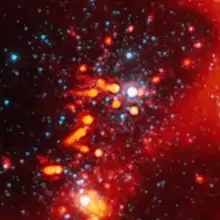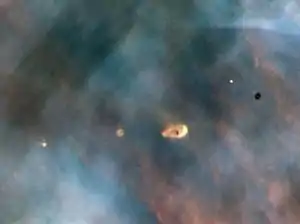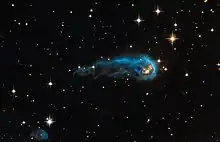Proplyd
A proplyd, a syllabic abbreviation of an ionized protoplanetary disk, is an externally illuminated photoevaporating disk around a young star. Nearly 180 proplyds have been discovered in the Orion Nebula.[1] Images of proplyds in other star-forming regions are rare, while Orion is the only region with a large known sample due to its relative proximity to Earth.[2]
.jpg.webp)
History
In 1979 observations with the Lallemand electronic camera at the Pic-du-Midi Observatory showed six unresolved high-ionization sources near the Trapezium Cluster. These sources were not interpreted as proplyds, but as partly ionized globules (PIGs). The idea was that these objects are being ionized from the outside by M42.[3] Later observations with the Very Large Array showed solar-system-sized condensations associated with these sources. Here the idea appeared that these objects might be low-mass stars surrounded by an evaporating protostellar accretion disk.[4]
Proplyds were clearly resolved in 1993 using images of the Hubble Space Telescope Wide Field Camera and the term "proplyd" was used.[5]
Characteristics
In the Orion Nebula the proplyds observed are usually one of two types. Some proplyds glow around luminous stars, in cases where the disk is found close to the star, glowing from the star's luminosity. Other proplyds are found at a greater distance from the host star and instead show up as dark silhouettes due to the self-obscuration of cooler dust and gases from the disk itself. Some proplyds show signs of movement from solar irradiance shock waves pushing the proplyds. The Orion Nebula is approximately 1,500 light-years from the Sun with very active star formation. The Orion Nebula and the Sun are in the same spiral arm of the Milky way Galaxy.[6][7][8][9]
A proplyd may form new planets and planetesimal systems. Current models show that the metallicity of the star and proplyd, along with the correct planetary system temperature and distance from the star, are keys to planet and planetesimal formation. To date, the solar system, with 8 planets, 5 dwarf planets and 5 planetesimal systems, is the largest planetary system found.[10][11][12] Most proplyds develop into a system with no planetesimal systems, or into one very large planetesimal system.[13][14][15][16][17][18]
Proplyds in other star-forming regions

Photoevaporating proplyds in other star forming regions were found with the Hubble Space Telescope. NGC 1977 currently represents the star-forming region with the largest number of proplyds outside of the Orion Nebula, with 7 proplyds. It is also the first and currently only instance where a B-type star, 42 Orionis is responsible for the photoevaporation.[19] Another type of photoevaporating proplyd was discovered with the Spitzer Space Telescope. These cometary tails represent dust being pulled away from the disks.[20] Westerhout 5 is a region with many dusty proplyds, especially around HD 17505.[21] These dusty proplyds are depleted of any gas in the outer regions of the disk, but the photoevaporation could leave an inner, more robust, and possibly gas-rich disk component of radius 5-10 astronomical units.[22]
The proplyds in the Orion Nebula and other star-forming regions represent proto-planetary disks around low-mass stars being externally photoevaporated. These low-mass proplyds are usually found within 0.3 parsec (60,000 astronomical units) of the massive OB star and the dusty proplyds have tails with a length of 0.1 to 0.2 parsec (20,000 to 40,000 au).[20] There is a proposed type of intermediate massive counterpart, called proplyd-like objects. Objects in NGC 3603 and later in Cygnus OB2 were proposed as intermediate massive versions of the bright proplyds found in the Orion Nebula. The proplyd-like objects in Cygnus OB2 for example are 6 to 14 parsec distant to a large collection of OB stars and have tail lengths of 0.11 to 0.55 parsec (24,000 to 113,000 au).[23][24] The nature of proplyd-like objects as intermediate massive proplyds is partly supported by a spectrum for one object, which showed that the mass loss rate is higher than the mass accretion rate. Another object did not show any outflow, but accretion.[25]
Gallery
 View of several proplyds within the Orion Nebula taken by the Hubble Space Telescope
View of several proplyds within the Orion Nebula taken by the Hubble Space Telescope.jpg.webp) Very bright proplyd 181-825 in the Orion Nebula, from Hubble Space Telescope
Very bright proplyd 181-825 in the Orion Nebula, from Hubble Space Telescope.jpg.webp) Dark proplyd 132-1832 in the Orion Nebula, from Hubble Space Telescope
Dark proplyd 132-1832 in the Orion Nebula, from Hubble Space Telescope.jpg.webp) Bright proplyd 170-249 in the Orion Nebula, from Hubble Space Telescope. The upward tail is a jet of dust and gas blowing away from the excited proplyd
Bright proplyd 170-249 in the Orion Nebula, from Hubble Space Telescope. The upward tail is a jet of dust and gas blowing away from the excited proplyd An image of a proplyd in the star-forming region NGC 1977 taken by the Hubble Space Telescope
An image of a proplyd in the star-forming region NGC 1977 taken by the Hubble Space Telescope A so-called proplyd-like object, which is being illuminated by massive stars of the Cygnus OB2 association
A so-called proplyd-like object, which is being illuminated by massive stars of the Cygnus OB2 association
See also
References
- Ricci, L.; et al. (2008). "The Hubble Space Telescope/Advanced Camera for Surveys Atlas of Protoplanetary Disks in the Great Orion Nebula". Astronomical Journal. 136 (5): 2136–2151. Bibcode:2008AJ....136.2136R. doi:10.1088/0004-6256/136/5/2136.
- Sharkey, Colleen; Ricci, Luca (Dec 14, 2009). "Born in beauty: proplyds in the Orion Nebula" (Press release). Hubble/ESA, Garching, Germany. NASA/ESA. Retrieved Aug 4, 2015.
- Laques, P.; Vidal, J. L. (March 1979). "Detection of a new kind of condensations in the center of the Orion Nebula, by means of S 20 photocathodes associated with a Lallemand electronic camera". Astronomy & Astrophysics. 73: 97–106. Bibcode:1979A&A....73...97L. ISSN 0004-6361.
- Churchwell, E.; Felli, M.; Wood, D. O. S.; Massi, M. (October 1987). "Solar System--sized Condensations in the Orion Nebula". Astrophysical Journal. 321: 516. Bibcode:1987ApJ...321..516C. doi:10.1086/165648. ISSN 0004-637X.
- O'dell, C. R.; Wen, Zheng; Hu, Xihai (June 1993). "Discovery of New Objects in the Orion Nebula on HST Images: Shocks, Compact Sources, and Protoplanetary Disks". Astrophysical Journal. 410: 696. Bibcode:1993ApJ...410..696O. doi:10.1086/172786. ISSN 0004-637X.
- Space Telescope, Born in beauty: proplyds in the Orion Nebula, 14 December 2009
- Space Telescope, Proplyds
- Nemiroff, R.; Bonnell, J., eds. (22 December 2009). "Planetary Systems Now Forming in Orion". Astronomy Picture of the Day. NASA.
- Nemiroff, R.; Bonnell, J., eds. (7 December 1996). "Planetary Systems Now Forming in Orion". Astronomy Picture of the Day. NASA.
- Windows 2 Universe, Solar System
- universetoday.com, Solar System, by Matt Williams, 25 June 2016
- universetoday.com, Inner Planets of Our Solar System, by Matt Williams, 25 June 2016
- Caltech, Planet-Metallicity Correlation - The Rich Get Richer, by Ji Wang, Planet-Metallicity Correlation
- The Planet-Metallicity Correlation. 2005, April 200, by Debra A. Fischer, Jeff Valenti
- arxiv.org, Revealing A Universal Planet-Metallicity Correlation For Planets of Different Sizes Around Solar-Type Stars, by Ji Wang, Debra A. Fischer, 29 Oct 2013
- Astrobiology Magazine, astrobio.net, When Stellar Metallicity Sparks Planet Formation, By Ray Sanders, 9 April 2012
- From Lithium to Uranium (IAU S228): Elemental Tracers of Early Cosmic Evolution By International Astronomical Union. Symposium, by Vanessa Hill, Patrick Francois, Francesca Primas, page 509-511, "the G star problem"
- Oxford Journals Dynamics and accretion of planetesimals, by Eiichiro Kokubo1 and Shigeru, June 14, 2012
- Kim, Jinyoung Serena; Clarke, Cathie J.; Fang, Min; Facchini, Stefano (July 2016). "Proplyds Around a B1 Star: 42 Orionis in NGC 1977". The Astrophysical Journal. 826 (1): L15. arXiv:1606.08271. Bibcode:2016ApJ...826L..15K. doi:10.3847/2041-8205/826/1/L15. hdl:10150/621402. ISSN 2041-8205. S2CID 118562469.
- Balog, Zoltan; Rieke, G. H.; Su, Kate Y. L.; Muzerolle, James; Young, Erick T. (2006-09-25). "Spitzer MIPS 24 μm Detection of Photoevaporating Protoplanetary Disks". The Astrophysical Journal Letters. 650 (1): L83. arXiv:astro-ph/0608630. Bibcode:2006ApJ...650L..83B. doi:10.1086/508707. ISSN 1538-4357.
- Koenig, X. P.; Allen, L. E.; Kenyon, S. J.; Su, K. Y. L.; Balog, Z. (2008-10-03). "Dusty Cometary Globules in W5". The Astrophysical Journal Letters. 687 (1): L37. arXiv:0809.1993. Bibcode:2008ApJ...687L..37K. doi:10.1086/593058. ISSN 1538-4357.
- Balog, Zoltan; Rieke, George H.; Muzerolle, James; Bally, John; Su, Kate Y. L.; Misselt, Karl; Gáspár, András (November 2008). "Photoevaporation of Protoplanetary Disks". The Astrophysical Journal. 688 (1): 408. arXiv:0807.3724. Bibcode:2008ApJ...688..408B. doi:10.1086/592063. ISSN 0004-637X.
- Wright, Nicholas J.; Drake, Jeremy J.; Drew, Janet E.; Guarcello, Mario G.; Gutermuth, Robert A.; Hora, Joseph L.; Kraemer, Kathleen E. (February 2012). "Photoevaporating Proplyd-Like Objects in Cygnus Ob2". The Astrophysical Journal. 746 (2): L21. arXiv:1201.2404. Bibcode:2012ApJ...746L..21W. doi:10.1088/2041-8205/746/2/L21. ISSN 2041-8205. S2CID 16509383.
- Brandner, Wolfgang; Grebel, Eva K.; Chu, You-Hua; Dottori, Horacio; Brandl, Bernhard; Richling, Sabine; Yorke, Harold W.; Points, Sean D.; Zinnecker, Hans (January 2000). "HST/WFPC2 and VLT/ISAAC Observations of Proplyds in the Giant H II Region NGC 3603*". The Astronomical Journal. 119 (1): 292. arXiv:astro-ph/9910074. Bibcode:2000AJ....119..292B. doi:10.1086/301192. ISSN 1538-3881. S2CID 15502401.
- Guarcello, M. G.; Drake, J. J.; Wright, N. J.; García-Alvarez, D.; Kraemer, K. E. (September 2014). "Accretion and Outflow in the Proplyd-Like Objects Near Cygnus Ob2". The Astrophysical Journal. 793 (1): 56. arXiv:1409.1017. Bibcode:2014ApJ...793...56G. doi:10.1088/0004-637X/793/1/56. ISSN 0004-637X.